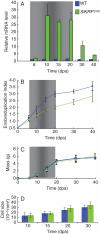Elucidating the functional role of endoreduplication in tomato fruit development
- PMID: 21199834
- PMCID: PMC3091799
- DOI: 10.1093/aob/mcq257
Elucidating the functional role of endoreduplication in tomato fruit development
Abstract
Background: Endoreduplication is the major source of endopolyploidy in higher plants. The process of endoreduplication results from the ability of cells to modify their classical cell cycle into a partial cell cycle where DNA synthesis occurs independently from mitosis. Despite the ubiquitous occurrence of the phenomenon in eukaryotic cells, the physiological meaning of endoreduplication remains vague, although several roles during plant development have been proposed, mostly related to cell differentiation and cell size determination.
Scope: Here recent advances in the knowledge of endoreduplication and fruit organogenesis are reviewed, focusing on tomato (Solanum lycopersicum) as a model, and the functional analyses of endoreduplication-associated regulatory genes in tomato fruit are described.
Conclusions: The cyclin-dependent kinase inhibitory kinase WEE1 and the anaphase promoting complex activator CCS52A both participate in the control of cell size and the endoreduplication process driving cell expansion during early fruit development in tomato. Moreover the fruit-specific functional analysis of the tomato CDK inhibitor KRP1 reveals that cell size and fruit size determination can be uncoupled from DNA ploidy levels, indicating that endoreduplication acts rather as a limiting factor for cell growth. The overall functional data contribute to unravelling the physiological role of endoreduplication in growth induction of fleshy fruits.
Figures



Similar articles
-
The cell cycle-associated protein kinase WEE1 regulates cell size in relation to endoreduplication in developing tomato fruit.Plant J. 2007 Aug;51(4):642-55. doi: 10.1111/j.1365-313X.2007.03167.x. Epub 2007 Jun 22. Plant J. 2007. PMID: 17587306
-
The Anaphase Promoting Complex activator CCS52A, a key factor for fruit growth and endoreduplication in Tomato.Plant Signal Behav. 2010 Aug;5(8):985-7. doi: 10.4161/psb.5.8.12222. Epub 2010 Aug 1. Plant Signal Behav. 2010. PMID: 20671429 Free PMC article.
-
The specific overexpression of a cyclin-dependent kinase inhibitor in tomato fruit mesocarp cells uncouples endoreduplication and cell growth.Plant J. 2011 Feb;65(4):543-56. doi: 10.1111/j.1365-313X.2010.04446.x. Epub 2011 Jan 4. Plant J. 2011. PMID: 21288265
-
Endoreduplication in plant organogenesis: a means to boost fruit growth.J Exp Bot. 2023 Oct 31;74(20):6269-6284. doi: 10.1093/jxb/erad235. J Exp Bot. 2023. PMID: 37343125 Review.
-
Fruit growth-related genes in tomato.J Exp Bot. 2015 Feb;66(4):1075-86. doi: 10.1093/jxb/eru527. Epub 2015 Jan 7. J Exp Bot. 2015. PMID: 25573859 Review.
Cited by
-
Ammonium treatment inhibits cell cycle activity and induces nuclei endopolyploidization in Arabidopsis thaliana.Planta. 2024 Mar 20;259(5):94. doi: 10.1007/s00425-024-04372-8. Planta. 2024. PMID: 38509428
-
Control of cell proliferation, endoreduplication, cell size, and cell death by the retinoblastoma-related pathway in maize endosperm.Proc Natl Acad Sci U S A. 2013 May 7;110(19):E1827-36. doi: 10.1073/pnas.1304903110. Epub 2013 Apr 22. Proc Natl Acad Sci U S A. 2013. PMID: 23610440 Free PMC article.
-
Characterization of the procera tomato mutant shows novel functions of the SlDELLA protein in the control of flower morphology, cell division and expansion, and the auxin-signaling pathway during fruit-set and development.Plant Physiol. 2012 Nov;160(3):1581-96. doi: 10.1104/pp.112.204552. Epub 2012 Aug 31. Plant Physiol. 2012. PMID: 22942390 Free PMC article.
-
The ORGAN SIZE (ORG) locus modulates both vegetative and reproductive gigantism in domesticated tomato.Ann Bot. 2023 Dec 30;132(7):1233-1248. doi: 10.1093/aob/mcad150. Ann Bot. 2023. PMID: 37818893 Free PMC article.
-
Cell cycle control and seed development.Front Plant Sci. 2014 Sep 23;5:493. doi: 10.3389/fpls.2014.00493. eCollection 2014. Front Plant Sci. 2014. PMID: 25295050 Free PMC article. Review.
References
-
- Alpert KB, Grandillo S, Tanksley SD. fw2·2: a major QTL controlling fruit weight is common to both red- and green-fruited tomato species. Theoretical Applied Genetics. 1995;91:994–1000. - PubMed
-
- Barow M, Meister A. Endopolyploidy in seed plants is differently correlated to systematics, organ, life strategy and genome size. Plant Cell Environment. 2003;26:571–584.
-
- Barow M. Endopolyploidy in seed plants. BioEssays. 2006;28:271–281. - PubMed
-
- Bemis SM, Torii KU. Autonomy of cell proliferation and developmental programs during Arabidopsis aboveground organ morphogenesis. Developmental Biology. 2007;304:367–381. - PubMed

